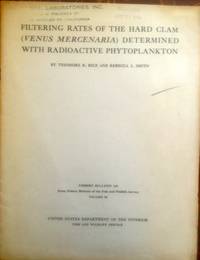FILTERING RATES OF THE HARD CLAM (VENUS MERCENARIA) DETERMINED WITH RADIOACTIVE PHYTOPLANKTON by Rice,T.R.& Smith,R.J - 1958-01-01
by Rice,T.R.& Smith,R.J

FILTERING RATES OF THE HARD CLAM (VENUS MERCENARIA) DETERMINED WITH RADIOACTIVE PHYTOPLANKTON
by Rice,T.R.& Smith,R.J
- Used
- Acceptable
- Paperback
USDI/FWS/BCF Bul.129, 1958-01-01. Paperback. Acceptable. United States Dept of the Interior Fish and Wild Life Service, Fishery Bulletin 129, From Fishery Bulletin of the Fish and Wildlife Service Volume [Published date: 1958]. Booklet, 12 pages (pages 73 - 82). In acceptable+ condition. Grey paper covers have a few small nicks and light creasing to edges. Original owner's address and date received stamped on front covers. Light overall scuffing, aging and soiling to covers as well. Binding tight (staple bound). Damp-staining to top corners of pages. Otherwise pages are lightly aged but unmarked. NOT Ex-Library. [From Abstract] Filtering rate. of the hard clam, Venus mercenary L., were determined by ascertaining the number of radioactive phytoplankton removed from water pumped through the filtering mechanism of the clam. If the cells are not^ompletely filtered from the water pumped, the filtering rate of the clam is less than the pumping rate. The term "filtering rate" refers to the volume of water from which the cells are removed per unit of time.The labeling of algae with radioactive phosphorus made it possible to follow smaller initial populations than have been used in most previous investigations, yet it provided a means of accurately measuring slight changes in these populations. The number of cells present at the beginning of an experiment and the size of these cells influencedthe filtering rate. The filtering rate in unialgal suspensions was different from that in mixed suspensions. The filtering rate in natural populations of phytoplankton was higher than in unialgal suspensions of green algae and lower than in unialgal suspensions of diatoms.Silt had an adverse effect on the hard clam, since it reduced the filtering rate and stimulated, th,e formation of Pseudofeces. A similar effect was produced by thepresence of Chlorella in the water. In relating filtering rates to size of clams, more water per gram of meat was filtered by small clams than by large clams.
-
Bookseller
Independent bookstores
(US)
- Format/Binding Paperback
- Book Condition Used - Acceptable
- Quantity Available 1
- Binding Paperback
- Publisher USDI/FWS/BCF Bul.129
- Date Published 1958-01-01
- Keywords Marine Biology, Sharp Estate